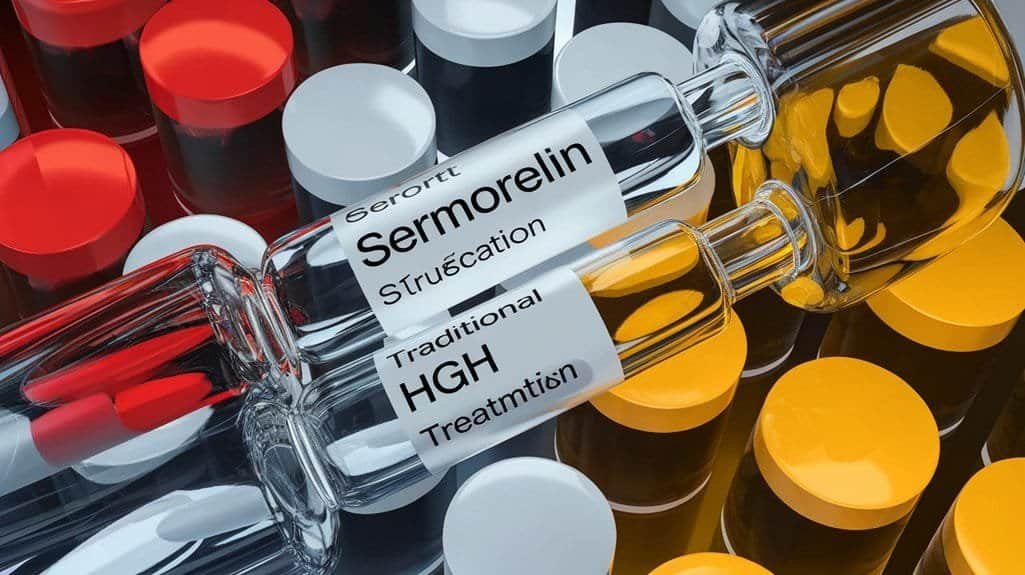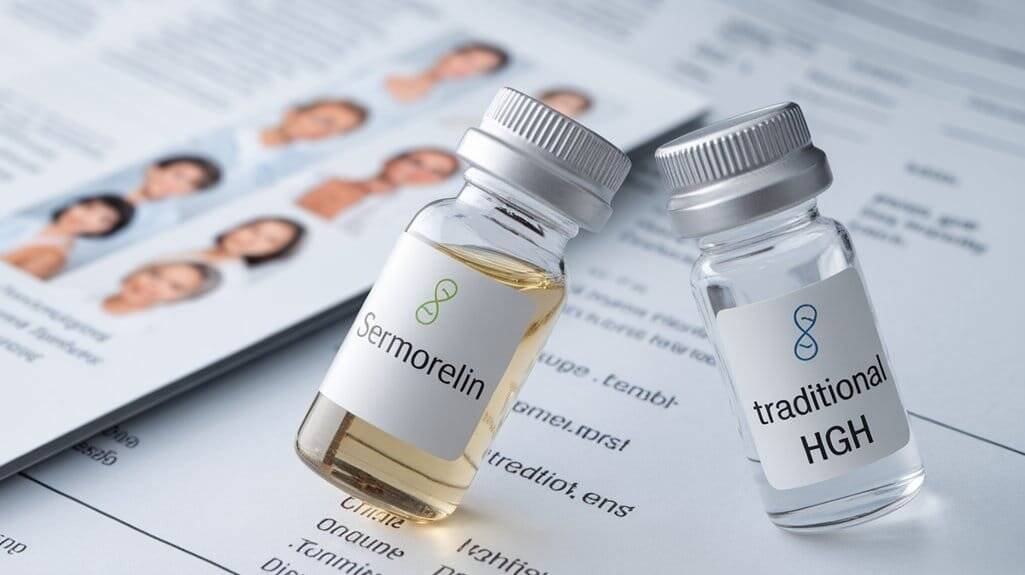Sermorelin and traditional HGH serve different purposes in addressing growth hormone deficiency. Sermorelin stimulates your body's natural growth hormone release, leading to gradual benefits like improved muscle growth and sleep quality, and has fewer side effects. In contrast, HGH delivers direct hormone supplementation, yielding faster results but carrying higher risks. Your choice depends on your health goals, safety preferences, and budget. Explore the nuanced differences further to better understand which option suits you best.
Key Takeaways
- Sermorelin stimulates natural growth hormone production by targeting GHRH receptors, while HGH directly increases growth hormone levels in the body.
- Sermorelin is associated with fewer and milder side effects compared to the higher risks linked to HGH, such as acromegaly.
- Treatment duration for Sermorelin varies individually, focusing on gradual improvements, whereas HGH often requires long-term use with more intensive monitoring.
- Sermorelin is generally more cost-effective, ranging from $200 to $400 per month, compared to HGH's $1,000 to $3,000 monthly expense.
- Ideal candidates for both therapies include those with diagnosed growth hormone deficiency, with health profiles guiding the choice between the two.
Definition and Mechanisms of Action

Sermorelin and traditional human growth hormone (HGH) serve distinct but essential roles in promoting growth and metabolism.
Sermorelin, a synthetic peptide comprised of 29 amino acids, mimics the amino-terminal segment of natural growth hormone-releasing hormone (GHRH). Its mechanism overview reveals that it binds to GHRH receptors, prompting the pituitary gland to secrete growth hormone (GH). Notably, sermorelin's ability to stimulate the pituitary gland supports the preservation of the growth hormone neuroendocrine axis with aging. Additionally, the use of Sermorelin promotes gradual muscle development and fat metabolism improvements over time. Research suggests that sermorelin can lead to increased energy levels and improved overall well-being.
In contrast, HGH, a 191-amino acid polypeptide, directly supplements GH levels, circumventing natural regulatory pathways and stimulating the liver to produce insulin-like growth factor-1 (IGF-1).
The disparities in peptide structure and mechanism of action underscore their unique pharmacological profiles.
Understanding these functions allows for informed decisions regarding treatment options tailored to growth hormone deficiencies.
Key Benefits and Effects Comparison
While both Sermorelin and traditional HGH offer distinct benefits for health and performance, their effects vary considerably based on individual needs and treatment goals.
Sermorelin can enhance restorative sleep, promote lean muscle growth, and aid in weight management through natural HGH stimulation, offering valuable therapeutic outcomes without disrupting hormonal balance. This approach supports gradual improvements in endurance and joint health, ideal for recovery and physical performance.
Conversely, HGH delivers faster results, particularly in cognitive function, skin elasticity, and cardiovascular health, but often requires careful monitoring to guarantee quality assurance.
Ultimately, your choice hinges on whether you prefer a natural, gradual enhancement of HGH levels or immediate, potent effects from external supplementation.
Safety Profiles and Side Effects

When considering the safety profiles and side effects of Sermorelin versus traditional HGH, you'll encounter distinct differences in their risks.
Sermorelin generally offers a safer option with fewer and less severe side effects, while traditional HGH carries higher risks of serious complications and dependencies.
Understanding these profiles, along with the necessity for ongoing medical monitoring, is essential for making an informed decision.
Side Effects Comparison
Both Sermorelin and traditional HGH therapies have distinct safety profiles and side effects that warrant careful consideration. Sermorelin's side effects are generally mild and temporary, including injection site reactions and mild headaches.
In contrast, traditional HGH can lead to severe conditions like acromegaly and cardiovascular issues due to its bypass of natural hormone regulation.
While both therapies demand medical supervision to manage side effects effectively, Sermorelin's natural stimulation of growth hormone production makes it a safer option. Additionally, well-executed injection techniques can minimize local reactions with Sermorelin.
Ultimately, understanding these side effects helps you to make informed choices about your treatment while ensuring the best health outcomes through careful monitoring and management.
Safety Concerns Addressed
Safety concerns regarding Sermorelin and traditional HGH treatments are critical to contemplate when evaluating their use.
Sermorelin is generally seen as safer because it stimulates natural hormone production, minimizing overdose risks and supporting hormone regulation through the body's feedback mechanisms.
Clinical trials indicate that serious side effects are rare with Sermorelin, often limited to mild injection site reactions.
In contrast, traditional HGH can lead to significant hormonal disruptions and carries a higher risk of adverse effects.
Long-term use of Sermorelin appears safe, with a favorable profile compared to HGH.
However, pre-existing health conditions may necessitate caution.
Consequently, understanding these safety profiles is essential for anyone considering their options in hormone therapy.
Monitoring Requirements Explained
Understanding the monitoring requirements for Sermorelin and traditional HGH is essential for ensuring safe and effective hormone therapy. Sermorelin's monitoring frequency is typically less intense, involving blood tests every 3-6 months to tailor treatment adjustments based on your IGF-1 levels.
In contrast, HGH often necessitates more frequent assessments due to its higher side effect risk profile. Key aspects include:
- Regular follow-up appointments for ongoing assessment.
- Monitoring of blood glucose levels for insulin sensitivity.
- Evaluation of common side effects, like injection site reactions.
With proper oversight, you'll not only gauge the effectiveness of your treatment but also nip any potential issues in the bud, ensuring a safer therapeutic journey.
Ideal Candidates for Treatment

If you're experiencing symptoms of growth hormone deficiency, you might consider treatments like Sermorelin or HGH.
Age and overall health play significant roles in determining your suitability, especially if you've noticed declines in energy or muscle mass.
Understanding these factors can help you select the most effective therapy for your needs.
Growth Hormone Deficiency
Growth hormone deficiency (GHD) can greatly impact health and development in both children and adults, making it essential to identify ideal candidates for treatment. Individuals diagnosed with GHD typically benefit from both HGH and sermorelin therapy, especially those with confirmed deficiencies.
Essential considerations include:
- The potential for improved body composition and exercise capacity.
- The importance of proper diagnosis through stimulation tests and clinical evaluation.
- The individual's health status, particularly for those with irreversible pituitary damage.
Treatment options such as HGH and sermorelin aim to enhance overall well-being by addressing growth hormone levels, promoting better quality of life and metabolic health.
Ensuring correct diagnosis can pave the way for effective treatment outcomes in patients facing these challenges.
Age and Health Factors
Determining the right candidates for treatment involves evaluating age and various health factors that contribute to growth hormone deficiency.
Generally, individuals over 30 may start experiencing age-related symptoms, such as decreased muscle mass and energy levels, prompting interest in therapies like Sermorelin and HGH.
Your health profile plays a significant role in this decision. If you have conditions like decreased bone density or cardiovascular risks, Sermorelin's gradual approach may suit you better due to its minimal side effects.
However, if you require immediate results, HGH might be necessary.
Ultimately, modifying treatment based on your individual response and goals guarantees ideal outcomes, which aligns therapy with age-related health concerns and specific health conditions.
Administration Methods and Duration of Treatment
While both Sermorelin and traditional HGH involve injections, their administration methods and treatment durations differ markedly.
Sermorelin is administered via subcutaneous injections, mimicking the body's natural growth hormone cycles, typically in areas like the abdomen, thigh, or upper arm. In contrast, HGH is a direct injection of synthetic hormone, which you can self-administer or receive from a provider.
- The emotional weight of your health journey hangs in balance.
- Understanding your administration techniques empowers you.
- Embracing your treatment durations leads to informed choices.
Sermorelin's duration varies based on individual responses, while HGH requires long-term use with regular monitoring for adjustments.
Both therapies prioritize safety through sterile techniques and ongoing oversight.
Cost and Accessibility Considerations

The financial implications of choosing between Sermorelin and traditional HGH are significant and deserve careful attention. Sermorelin typically ranges from $200 to $400 per month, making it a more affordable option compared to HGH, which can cost between $1,000 and $3,000 monthly.
This disparity addresses affordability issues, particularly for patients lacking insurance coverage. While Sermorelin often requires self-pay due to insurance limitations—primarily not covered for off-label use—HGH coverage is tightly regulated and restricted to specific medical conditions.
Additionally, many patients face out-of-pocket expenses, necessitating careful budgeting beyond medication costs. Ultimately, your financial commitment must align with your treatment goals, making it critical to weigh the long-term economic impacts of each therapy option.
Long-Term Implications of Each Therapy
Understanding the long-term implications of Sermorelin and traditional HGH therapies is essential for making an informed decision about your health.
- Natural hormone production fosters sustainable growth
- Gradual improvements necessitate patience and commitment
- Risk management is crucial to avoid metabolic complications
Sermorelin promotes long-term sustainability by stimulating natural growth hormone production, enhancing muscle mass and bone density with reduced risk.
Unlike HGH, which carries potential metabolic risks and possible cancer concerns, Sermorelin's approach offers a more balanced hormonal regulation.
Furthermore, the absence of withdrawal symptoms provides a safer exit strategy.
Conversely, traditional HGH can lead to rapid yet unsustainable outcomes, placing you at risk for tachyphylaxis and hormonal imbalances.
As a result, continuous monitoring during Sermorelin therapy enhances safety and long-term health benefits.
Frequently Asked Questions
Can Sermorelin Help With Weight Management and Fat Loss?
Sermorelin can aid in weight management by enhancing fat metabolism and promoting natural growth hormone production. This process supports lean muscle gain while encouraging fat breakdown, contributing to more effective weight loss and overall body composition improvement.
How Do Age and Lifestyle Affect Treatment Outcomes?
Just like a gardener nurtures plants, your age factors and lifestyle choices profoundly shape treatment outcomes. Optimize your environment—exercise regularly, eat well, and manage stress—to foster the healthiest hormonal landscape and guarantee successful interventions.
Are There Dietary Recommendations While on These Therapies?
When undergoing therapy, prioritize balanced meals and consider strategic meal timing to optimize nutrient absorption. Incorporate dietary supplements like vitamins and amino acids to enhance therapy effectiveness and support overall hormonal balance during treatment.
Can Exercise Enhance the Effects of Sermorelin or HGH?
Exercise greatly enhances growth hormone effects, maximizing both sermorelin and HGH benefits. The exercise impact on muscle strength and body composition improves recovery, promotes hypertrophy, and optimizes fat loss, aiding your overall health and performance.
What Is the Long-Term Impact on Hormonal Health?
Steering through hormonal health is like walking a tightrope; achieving long-term benefits hinges on maintaining that delicate hormonal balance. You'll find that sustainable approaches, like sermorelin, bolster natural production without destabilizing your endocrine system over time.
Conclusion
In conclusion, choosing between sermorelin and traditional HGH boils down to individual needs and goals. While sermorelin stimulates the body's natural growth hormone production, traditional HGH offers direct supplementation. Think of sermorelin as a gentle nudge, while HGH is a direct command. Each therapy comes with its unique safety profiles and costs, making it essential to weigh the benefits against potential side effects. Ultimately, consulting with a healthcare provider will guarantee you find the best path for your health.
References
- https://regenics.com/sermorelin-vs-hgh-key-differences-and-benefits-explained/
- https://www.invigormedical.com/anti-aging/4-fundamental-reasons-to-choose-sermorelin-over-hgh-for-anti-aging/
- https://www.rejuvimemedical.com/blog/sermorelin-hgh-therapy-baton-rouge/
- https://en.wikipedia.org/wiki/Sermorelin
- https://www.guidetopharmacology.org/GRAC/LigandDisplayForward?tab=clinical&ligandId=6998
- https://www.rxlist.com/sermorelin-acetate-drug.htm
- https://mynuceria.com/blog/sermorelin-therapy-benefits-dosage-side-effects
- https://geminihealthandwellness.com/health-wellness-blog/sermorelin-therapy-vs-testosterone-replacement-therapy-which-is-right-for-you
- https://www.innerbody.com/sermorelin
- https://www.healthline.com/health/sermorelin






